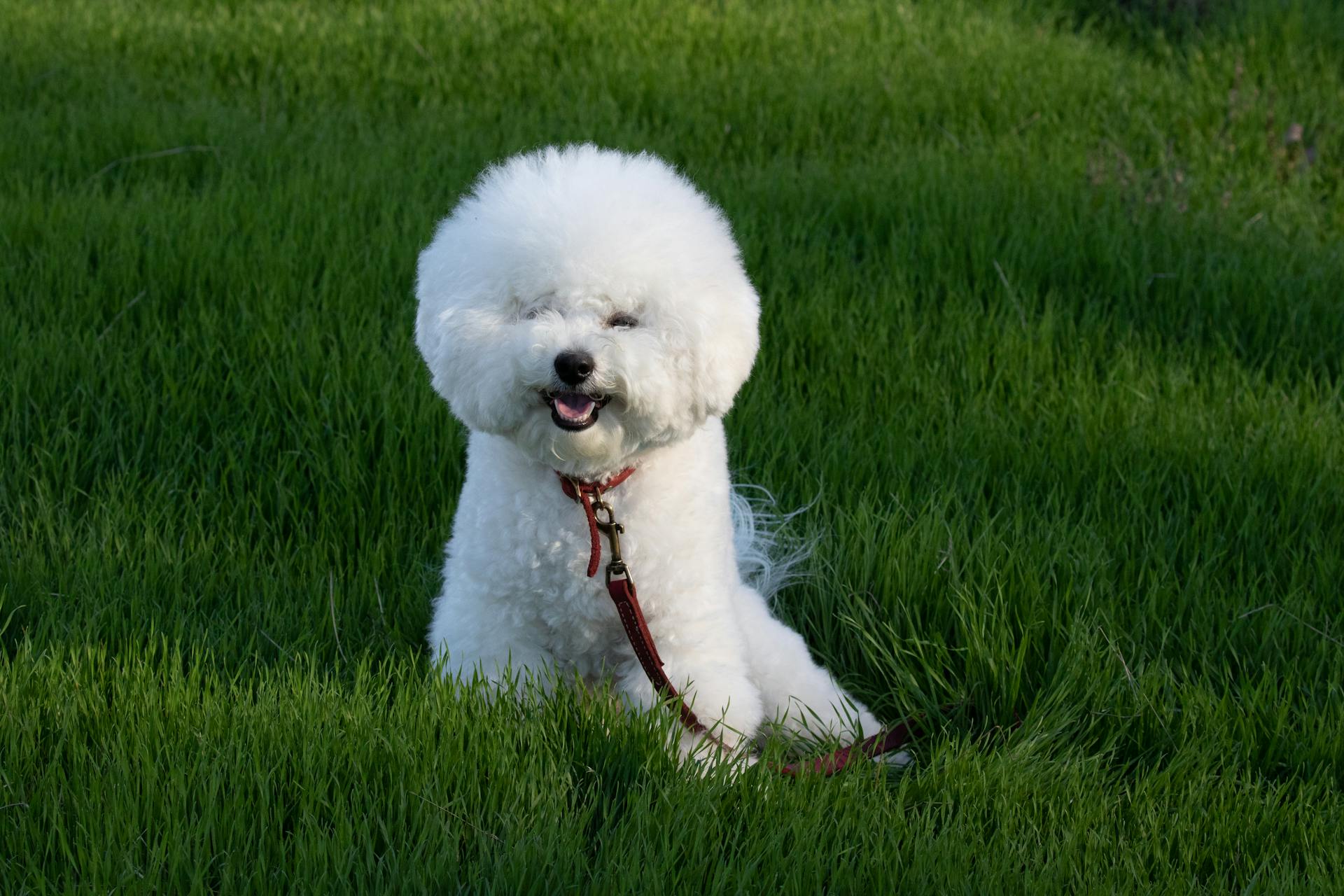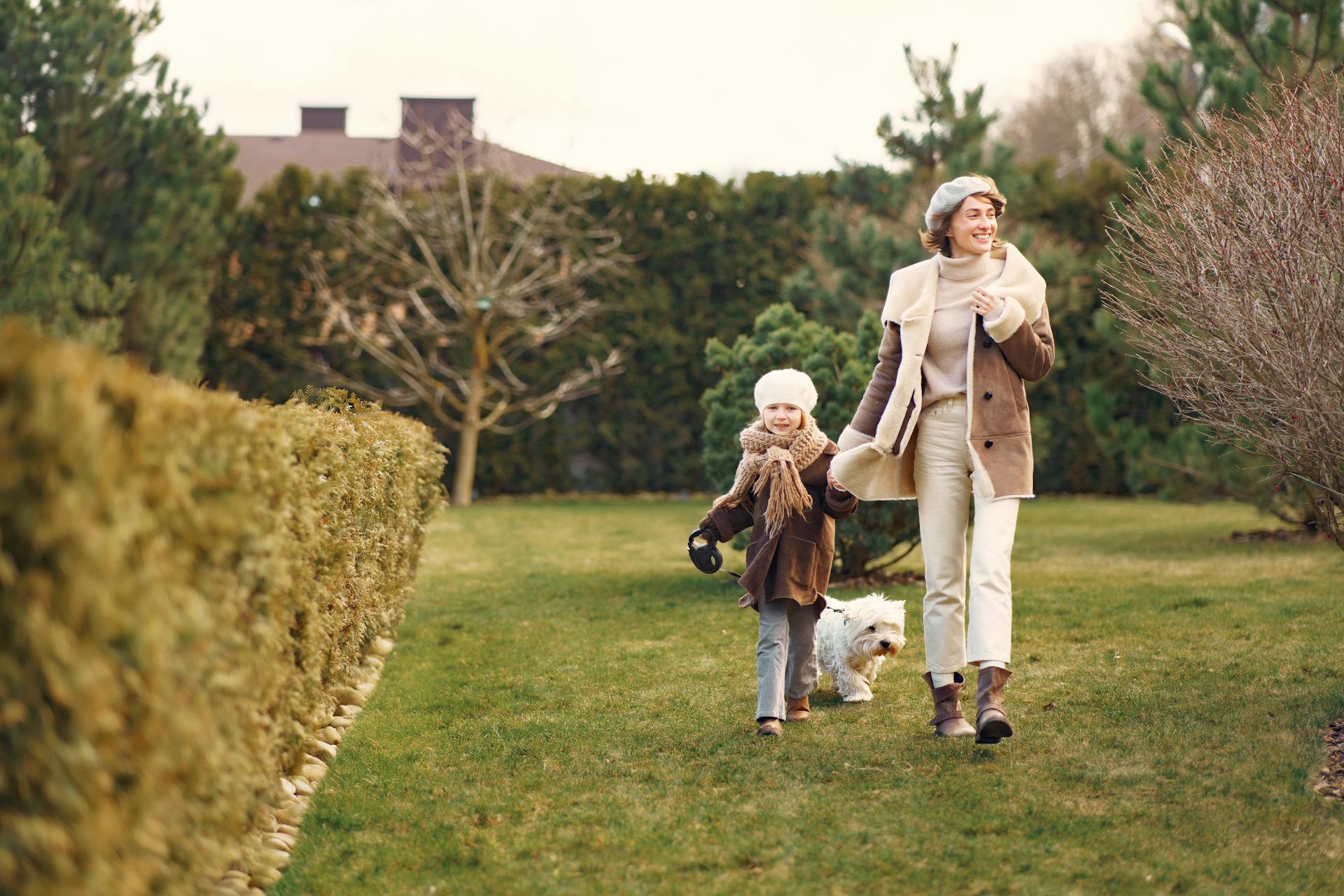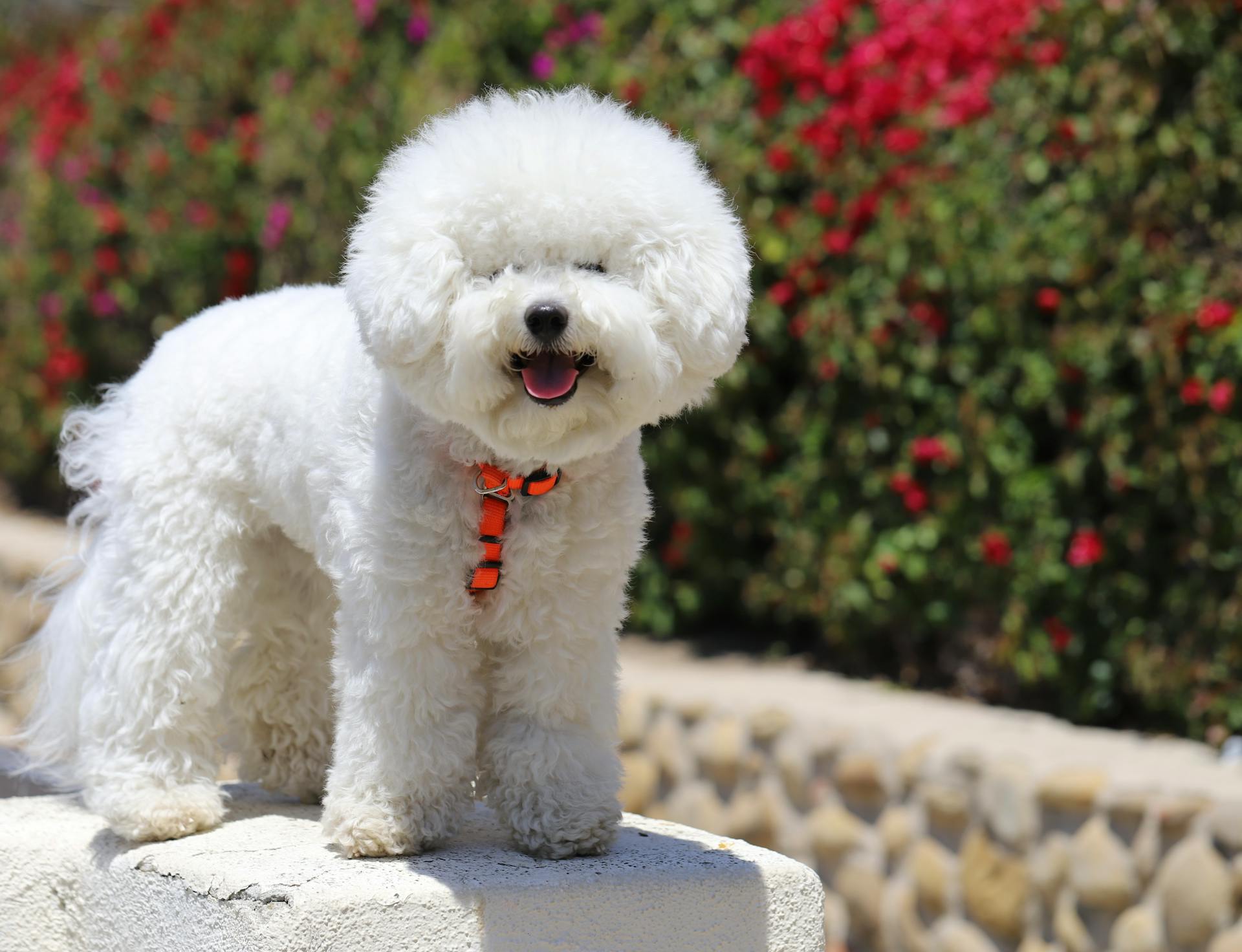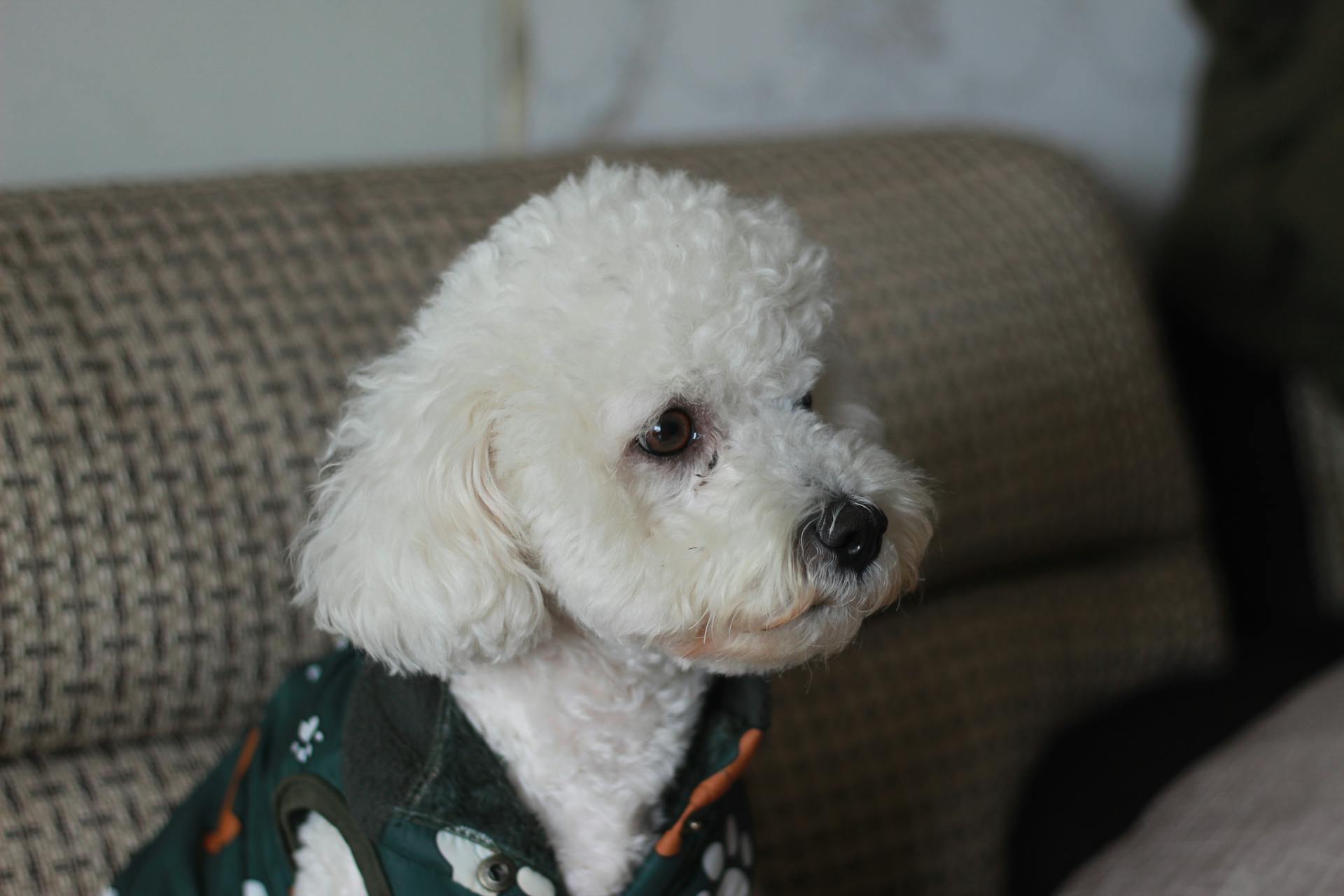
The Bichon Frise has a rich history that spans centuries, but its roots can be traced back to ancient times. The breed's ancestors were likely small, fluffy dogs that accompanied sailors and traders on their voyages.
These early dogs were often used as companions and entertainers, and their popularity grew as they became a favorite among the aristocracy in Europe. The name "Bichon" is thought to have originated from the French word "bichon", which means "curly."
The Bichon Frise's popularity waned during the Middle Ages, but it experienced a resurgence in the 19th century when it was brought back to Europe by sailors and traders. The breed's popularity continued to grow, and it became a favorite among royal families in Europe.
Curious to learn more? Check out: Small Breed Bichon Frise
Early History
The Bichon Frise's early history is a fascinating tale of how this charming breed became a beloved companion to royalty and nobility. The breed's origins date back to the Mediterranean region, where small lapdogs were bartered around for millennia.
Cleopatra, the legendary Egyptian queen, was said to be a fan of these small white dogs. The breed's modern development is believed to have begun on the Canary Island of Tenerife.
The Bichon Frise's association with European nobles began in the 13th century, particularly in Spain, Italy, and France. They were known as Barbichon-type dogs, an umbrella term for breeds like the Bolognese, Maltese, Havanese, and Bichon Frise.
These petite dogs quickly won over the hearts of royalty, with King Henry III of France being particularly enamored with them. He was known to carry his Bichons around in a tray-like basket suspended by neck ribbons.
The breed's popularity continued into the Renaissance period, with many Bichons appearing in portraits by famous artists like Titian. A celebrated painting by Titian depicts Federico Gonzaga, the duke of Mantua, with a wooly Bichon at his side.
By the 20th century, the Bichon Frise had become a beloved companion to many, but their numbers began to decline due to the shortages and austerities brought on by the two world wars. However, a few dedicated fanciers managed to save the breed by gathering Bichons off the streets of France and Belgium.
The breed was eventually recognized in France under the auspices of the Societé Centrale Canine in March 1933 as the "Bichon a Poil Frisé" – the Bichon of the curly hair.
Origins and Development
The Bichon Frise has a rich history that spans thousands of years. The breed's origins date back to ancient times, when small dogs were highly valued by the aristocracy for their companionship and status symbol.
In those days, small dogs were not only kept as pets but also served as guardians, alerting their owners to any irregularities. This unique combination of roles helped establish the breed's reputation as a loyal and trustworthy companion.
The Bichon Frise's modern history began in France, where it was highly prized by the upper class. However, the breed's exact origins are still a topic of debate, with some theories suggesting it descended from the Boloñés or the Bichon Maltés.
The Bichon Frise was first registered as a distinct breed in Belgium in 1924, marking the beginning of selective breeding for the modern Bichon Frise. Today, the breed is recognized for its unique appearance and charming personality.
Interestingly, the Bichon Frise's history is intertwined with that of other breeds, including the Bichon Habanero, which is believed to have originated from the Bichon Maltés or the Boloñés.
Geographic Spread
The Bichon Frise originated in the Mediterranean region, specifically in the island of Tenerife, Canary Islands, and the island of Tenerife's unique geography played a significant role in the breed's development.
Bichon Frises were popular companions among sailors and traders who traveled between the Canary Islands and mainland Europe, which helped spread the breed to various parts of the world.
España
In Spain, the Bichon was a beloved companion, especially in the royal courts of the 16th century.
The Bichon Tinerfeño was a popular breed among Spanish nobility, and its popularity was fueled by its exotic name, which sounded exciting to people in those times.
Spanish painters of the era often featured these dogs in their works, including the famous artist Goya, who was commissioned as the court painter to King Carlos IV in 1789.
Goya was not only a talented painter but also a skilled grabador al aguafuerte, and his artwork often included the Bichon Tinerfeño, showcasing its elegance and charm.
En Francia

In France, the Bichon gained popularity during the reign of Enrique III in the 16th century. The royal family adored these small white dogs, often carrying them around in decorative baskets.
They were so fond of their Bichons that they took them everywhere, even to formal events. The dogs were considered a status symbol, and their owners showed them off with pride.
The Bichon became the "mascota oficial" of the French court during the reign of Luis XIV, who ruled from 1643 to 1715. This was due to their small size and ease of transportation.
Many French paintings and ancient tapestries feature Bichons, often depicted in luxurious settings. These artworks date back to the 15th century, showcasing the breed's long history in France.
The Bichon's popularity declined during the French Revolution in 1789, but they experienced a resurgence during the reign of Napoleón III, who became emperor in 1852.
Related reading: French Mastiff History
EE.UU
EE.UU is a vast and diverse country, covering over 3.8 million square miles of land. From the frozen tundra of Alaska to the sun-kissed beaches of Miami, the country's geography is as varied as its people.

The contiguous United States is home to the Rocky Mountains, the Sierra Nevada, and the Appalachian Mountains, among others. These mountain ranges are a popular destination for outdoor enthusiasts.
The country's longest river, the Missouri River, stretches over 2,300 miles from its source in the Rocky Mountains to its confluence with the Mississippi River. This river has played a significant role in the country's history and economy.
From the bustling cities of New York and Los Angeles to the rural towns of the Midwest, the United States is a country of contrasts.
Gran Bretaña
The Bichon Frisé didn't arrive in Gran Bretaña until the early 1970s, with one individual being registered with the Kennel Club in 1957.
It wasn't until 1973 that the Sorstein family, from the US, brought two Bichon Frisé with them to the UK, marking the real beginning of the breed's presence in the country.
The two Bichon Frisé, Rava's Regal Valor of Reenroy and Jenny-Vive de Carlise, were crossed, and the first litter born in Gran Bretaña was in 1974.

Three of the puppies from this litter went back to the US, but two were shown in Gran Bretaña, with Carlise Cicero of Tresilva becoming a champion and siring a pup that would have a big influence on the breed in Sweden.
The breed's popularity grew rapidly, and by the end of the 1970s, the Bichon Frisé had won many admirers worldwide.
Show Ring and Popularity
The Bichon Frise's rise to show ring fame was nothing short of remarkable. In 1964, the Bichon Frise Club of America was founded in San Diego, marking a significant milestone in the breed's history.
The breed's popularity grew steadily, with the AKC accepting the Bichon into the Miscellaneous class in 1971. Two years later, the Bichon earned full breed recognition in the Non-Sporting Group.
In 2001, JR, a record-setting Bichon, became the AKC National Championship's first Best in Show winner.
Curious to learn more? Check out: Akc Bichon Frise
Taking to the Show Ring
In 1956, Helene and Francois Picault of Dieppe, France, arrived in America with six Bichons in tow, marking the beginning of the breed's journey in the United States.
The Picaults' goal was to establish the Bichon breed in America, and they succeeded in producing the first Bichon litter bred in the United States.
For several years, a small but dedicated group of breeders worked to stabilize important breed traits like size and facial expression.
The Bichon Frise Club of America was founded in San Diego in 1964, a significant milestone in the breed's development.
In 1971, the AKC accepted the Bichon into the Miscellaneous class, and full breed recognition in the Non-Sporting Group came in April 1973.
JR, a record-setting Bichon, became the AKC National Championship's first Best in Show winner in 2001, a historic achievement for the breed.
JR's impressive win was followed by another at Westminster two months later, making him the first Bichon to take the top prize at that prestigious venue.
Judge Dorothy Macdonald praised JR, calling him "as close to perfection as you can get."
Suggestion: Are Bichon Frise Good for First Time Owners
Today's
Today's Bichon Frise is a beloved breed for many reasons. They have a low-shedding, hypoallergenic coat that requires daily brushing and routine scissoring to maintain.

Their trainability, quickness, and deceptive sturdiness make them a natural for obedience and agility training. They're adaptable and don't need much hard exercise, making them ideal city dogs.
Bichons are social dogs that get on well with other dogs and children. They're alert and loyal to their favorite human, but they're not naturally protective, so they make nice little watchdogs.
Their happy-go-lucky personality draws smiles and hugs wherever they go. They're ideal therapy dogs, and it's no wonder why - they have a special knack for making people feel better.
Decline and Legacy
The Bichon Frise's popularity waned towards the end of the 19th century, and they became a less desirable pet.
It's surprising, given France's prosperity, but the Bichon Frise seemed to fall out of favor.
They could still be found in circuses and fairs, but were often referred to as "street dogs" or "small sheepdogs".
Their lives took a drastic turn, moving from the luxury they were once accustomed to to living on the streets, sometimes as beggars.
Sources
- https://www.akc.org/expert-advice/dog-breeds/the-bichon-frise-historys-sociable-survivor/
- https://es.wikipedia.org/wiki/Bich%C3%B3n_fris%C3%A9
- https://www.mundoanimalia.com/razas-perro/bichon-frise/
- https://kennelclubargentino.org.ar/bichon-frise-una-pequena-raza-real/
- https://www.hundeo.com/es/dog-breeds/bichon-frise/
Featured Images: pexels.com
